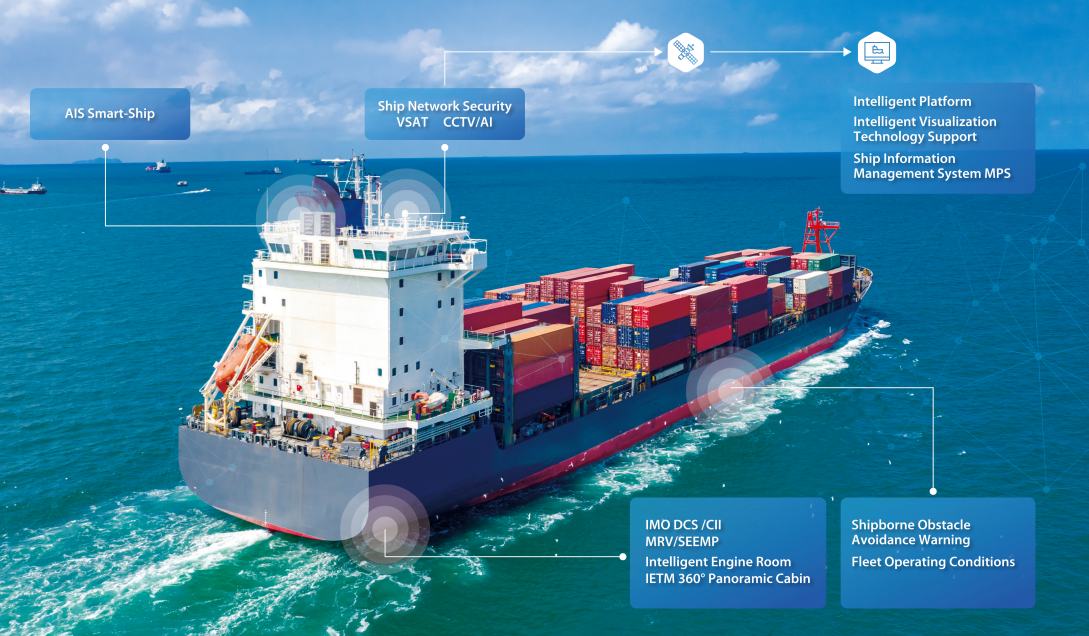
Introduction to Intelligent Ship

Intelligent Ship is a kind of modernized ship that integrates advanced information technology, automation technology, communication technology and ship engineering technology and other technologies.
1. Definition and Basic Concepts
Intelligent Ships is able to collect, process, and analyze data on the ship's itself and surrounding environment through various sensors, and make decisions on these data through computer systems and intelligent algorithms, so as to realize automation and intelligent operation in many aspects such as ship navigation, equipment operation and management, and cargo management.
2. Key Technologies
1. Sensing Technology
1.1 Sensors are the core equipment of Intelligent Ship sensing. For example, pressure sensors installed on the hull of a ship can monitor the draft depth of the ship in real time, helping the crew to understand the ship's load. There are also high-precision GPS (Global Positioning System) and BeiDou satellite navigation systems, which can accurately determine the ship's position, speed, heading and other information.
1.2 Radar and sonar are also important sensing devices. Radar is used to detect surface targets around the ship, such as other ships, buoys, etc., and its working principle is to transmit electromagnetic waves and receive reflected waves to obtain the target's distance, bearing, speed and other information. Sonar is mainly used for underwater detection, such as the detection of seabed topography, reefs and underwater objects, which is crucial for the safe navigation of ships, especially in shallow water areas and complex channel environments.
2. Communication Technology
Intelligent Ship rely on advanced communication technology to realize ship-shore and ship-ship information interaction. Among them, satellite communication is one of the main ways of long-distance communication, which can ensure smooth message exchanges between ships and shore control centers or other ships in the global scope. For example, in ocean voyage, the ship can send important information such as the ship's position and equipment status back to the shore through the satellite communication system, and at the same time, receive navigation instructions, weather forecasts and other information from the shore.
Another communication method is VHF (Very High Frequency) communication, which is used for short-range communication and is mainly used for voice communication between ships in harbors, coastal areas and other areas, and nearby ships and onshore traffic control departments.
3. Automation Technology
3.1 The navigation automation is an important manifestation of Intelligent Ship. The automatic rudder system can automatically adjust the rudder angle of the ship according to the set heading to keep the ship sailing along the predetermined route. For example, in the open sea, after the crew set the destination and route, the automatic rudder system can automatically respond to wind and waves and other disturbing factors, reducing the crew's workload of manually steering.
3.2 The remote control system can realize the long-distance control of the main engine in the cabin of the ship, and the crew can precisely adjust the rotational speed, power and other parameters of the main engine in the pilothouse or the centralized control room, so as to improve the operation efficiency of the ship's power system.
4. Data analysis and Decision-making Technologies
4.1 Intelligent Ship collects huge amounts of data, such as the operating parameters of ship equipment, navigation data, etc. Through data mining and machine learning algorithms, these data can be analyzed. For example, machine learning algorithms are used to analyze the historical failure data and current operation data of ship equipment, predict possible equipment failures, take maintenance measures in advance, and reduce the equipment failure rate.
4.2 Intelligent decision-making system can provide the optimal decision-making scheme for the navigation and operation of the ship according to the analysis results. For example, when encountering complicated weather and sea conditions, the decision-making system can choose the most suitable route or sailing speed by taking into account the ship's performance, cargo condition and other safety factors.
5. Characteristics of Intelligent Ship
5.1 Enhancing Navigation Safety
5.1.1 Intelligent Ship can sense changes in the surrounding environment in real time and detect potential dangers in advance. For example, in the case of poor visibility, its sensors and intelligent algorithms can more accurately detect the position and moving status of nearby ships, issue timely warnings and take measures to effectively avoid collision accidents.
5.1.2 The automatic collision avoidance system is an important guarantee for navigation safety. It can automatically calculate the best avoidance plan according to the international maritime collision avoidance rules and the dynamics of the surrounding ships, and assist the crew or automatically control the ship to carry out avoidance operations.
5.2 Boosting Operation Efficiency
5.2.1 In terms of cargo transportation, intelligent Ship can carry out real-time monitoring of the status of cargo. For example, for refrigerated cargo, it can accurately control the temperature and humidity of refrigerated containers to ensure the quality of cargo. Meanwhile, by optimizing route planning and considering factors such as weather, sea conditions and port congestion, it can shorten voyage time and reduce fuel consumption, thus improving operational efficiency.
5.2.2 Intelligent management of ship equipment can reduce maintenance time of failing equipment. Through the real-time monitoring of the state of the equipment and fault prediction, maintenance personnel can prepare maintenance tools and parts in advance, quickly respond to equipment failure, and shorten the equipment downtime.
5.3 Greater Protection of the Environment
5.3.1 Intelligent Ship is able to reduce fuel consumption by optimizing the ship's navigation operations. For example, the power and speed of the main engine are intelligently adjusted according to the sea state and the ship's load, so that the ship operates under the most economical working conditions and reduces the emission of greenhouse gases and pollutants.
5.3.2 Some intelligent ships are also equipped with advanced sewage and garbage treatment systems, which automatically monitor and treat sewage and garbage generated by the ship to ensure that the ship complies with environmental regulations.
6. Application Area and Prospect
6.1 Application Area
6.1.1 In the field of commercial shipping, Intelligent Ship can be applied to container ships, bulk carriers, tankers and other kinds of large commercial vessels to improve transportation efficiency and safety. For example, large container shipping companies can better manage their fleets and optimize the global route layout through intelligent ships.
6.1.2 In the field of marine scientific research, Intelligent Ship can provide a more stable and precise platform for scientific research. It can precisely control the ship's position in a specific sea area, facilitating the placement of scientific research equipment and data collection, such as deep-sea exploration and marine ecological research projects.
6.1.3 In the maritime law enforcement and military fields, the rapid response and precise operation of Intelligent Ship are also of great value. For example, maritime patrol vessels can utilize smart technology to quickly identify and track suspicious targets.
6.2 Prospect
6.2.1 As technology continues to advance, Intelligent Ship is expected to achieve a higher degree of autonomy. In the future, there may be unmanned smart ships that are monitored and operated through remote control centers, which will further change the landscape of the shipping industry.
6.2.2 Smart Ship will also integrate deeply with smart ports, smart logistics and other related industries to form a more efficient, safe and environmentally friendly maritime transportation ecosystem. For example, smart ships can be seamlessly connected with automated loading and unloading equipment in ports to realize rapid transshipment of goods.
Related news
- Philscom Participated in 2024 Saudi Maritime & Logistics Congress 2024-11-08 16:21:38
- Technological Research, Development, and Breakthrough 2024-11-08 16:20:50
- Signing Ceremony between Philscom and Alpha Power 2024-11-08 16:19:04